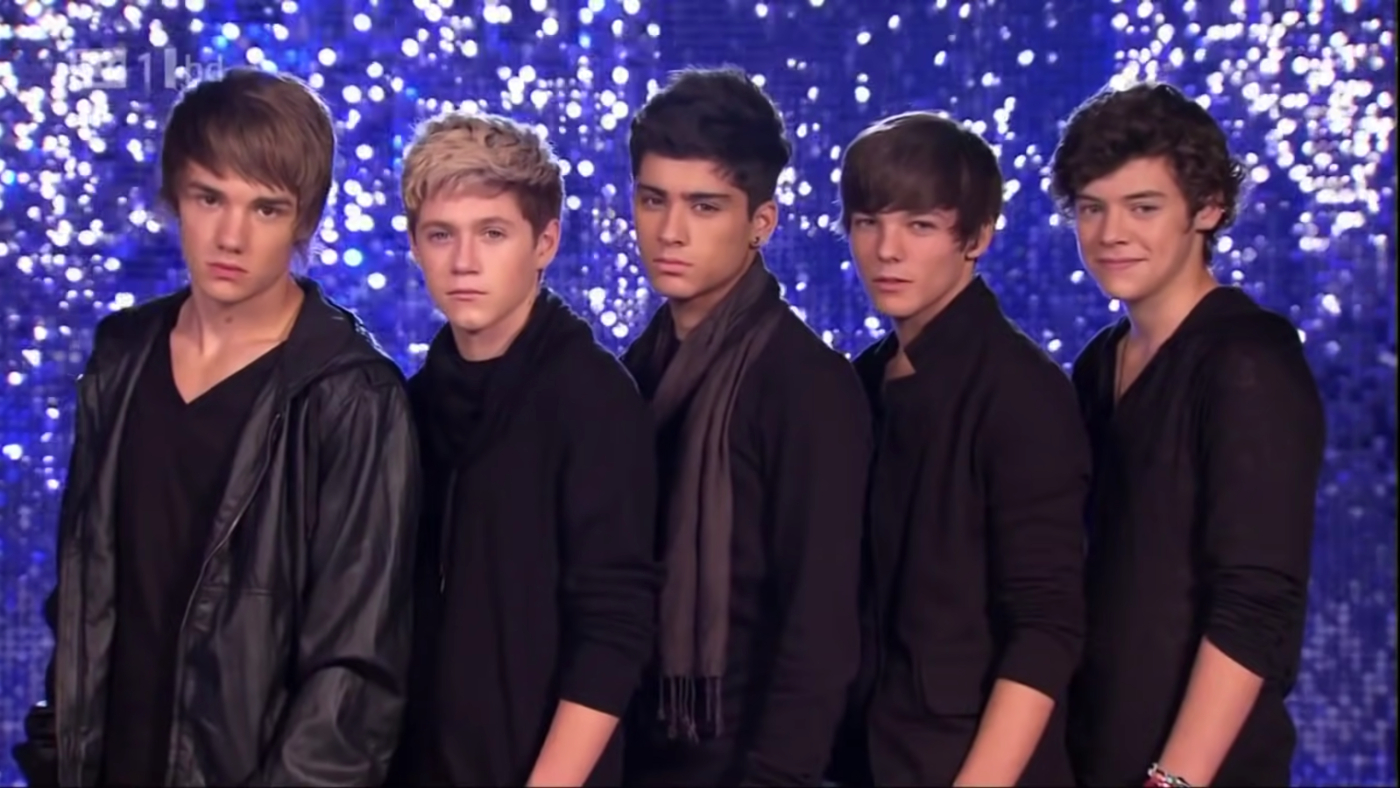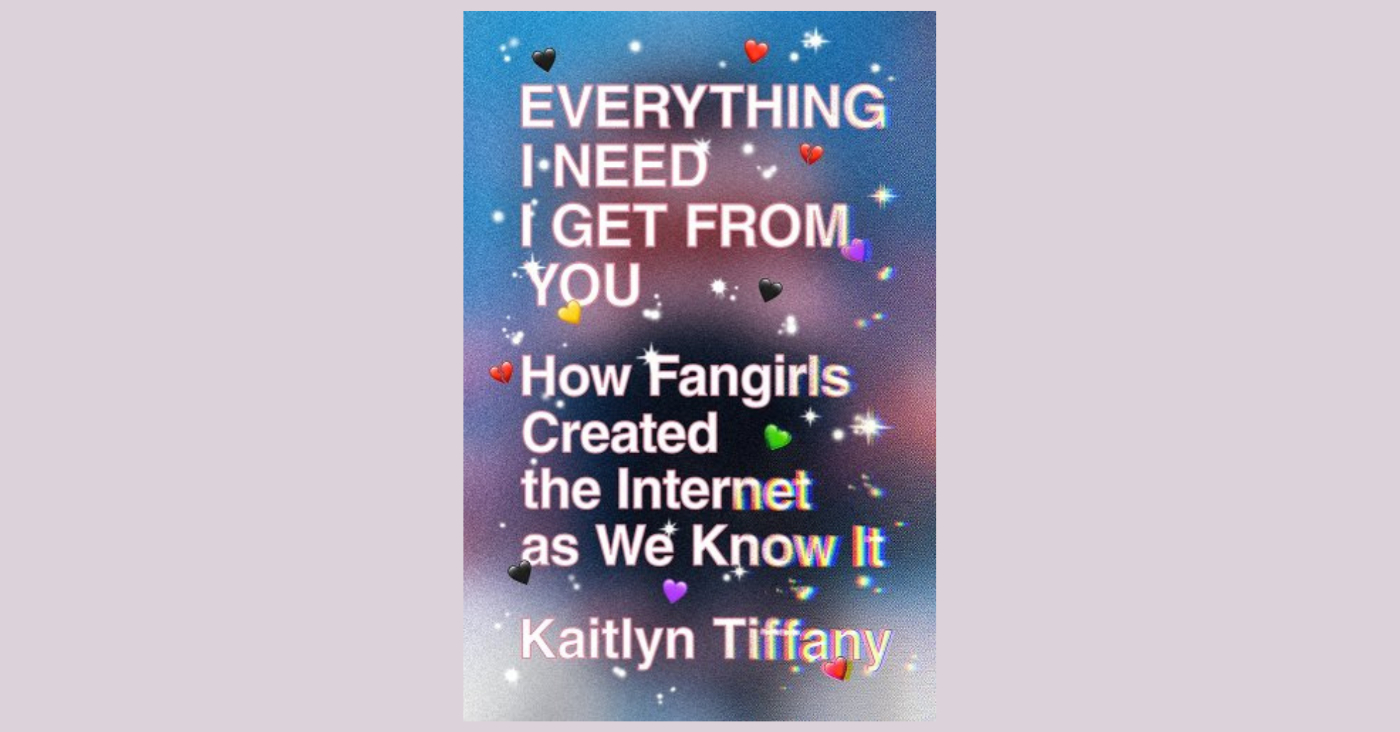
The Screaming Fangirls Who Forged the Internet
Book Review—Everything I Need I Get from You: How Fangirls Created the Internet as We Know It by Kaitlyn Tiffany
June 13, 2022
Everything I Need I Get From You: How Fangirls Created the Internet as We Know It by Kaitlyn Tiffany is an engaging look into One Direction’s online fame, the fangirls who propelled them to the top, and a wider exploration into the phenomenon of fandom—beautifully punctuated with autobiographical details from the author. It’s a must-read for anyone interested in understanding stan culture, the many shapes it takes in the present, and how it’s molded today’s internet.
On December 12, 2010 the musical act One Direction was eliminated from the seventh season of The X Factor. The UK-based reality talent show had brought together five individual contestants—Louis Tomlinson, Niall Horan, Harry Styles, Liam Payne and Zayn Malik—blending them into a single dreamy boy band, an idea credited to Simon Cowell. The actual winner of that season is hardly a household name—if you Google him, the top related question reads, “Where is Matt McArdle now?” One Direction, of course, went on to become one of the biggest bands in history, breaking beyond their British and Irish roots to worldwide appeal.
Their debut single is one you’ve heard just by being conscious—“What Makes You Beautiful” was certified quadruple platinum in the US and reached number one across various worldwide music charts. Though the band has been on indefinite hiatus since 2016, One Direction holds the record of the first band in American chart history to have their first four albums debut at number one. The craze around them has drawn comparisons to Beatlemania. In a YouTube video of the boy band's elimination from the show, the top comment reads “One Direction. The Band who lost the X-factor but won the world.”
In her book, Everything I Need I Get From You: How Fangirls Created the Internet as We Know It, author Kaitlyn Tiffany—a staff writer at The Atlantic covering internet culture and technology—describes One Direction as the “first internet boy band.” She chronicles the history of how “fangirls” across the internet propelled them from reality TV runner-ups to one of the most popular bands of all time. It was fangirls who made One Direction into the “biggest subculture on Tumblr” and a constant trending topic on Twitter. It was fangirls who created and proliferated memes and fanfiction—some “deep fried” and deranged—about the band across the internet, adding to the band’s lore and popularity. It was fangirls who filled the boys’ sold-out stadium and arena concerts across the world, hand-painted signs with declarations of love hoisted in the air, screaming lyrics and names and confessions and just screaming—occasionally until their lungs collapsed.
Tiffany writes the book from the vantage point of an ethnographer immersed in the world of fandom herself, both observer and participant. She’s a self-admitted fangirl, specifically a “Directioner” like the subjects of her study in this book. Her interest in the band was piqued after watching the One Direction documentary This is Us. She owns a “Mrs. Horan” sweatshirt. She’s screamed from the stands. The title of the book comes from her favorite 1D number, “I Want to Write You a Song”: “Ooh, everything I need I get from you, ooh, and giving back is all I wanna do, ooh.”
But the book isn’t really about One Direction, it’s about fans like her—the image of the screaming fangirl repeats and is explored throughout the book. While Tiffany uses One Direction as a lens, including rich details about the Directioners who have made the band part of their life’s project, the book is ultimately about the wider phenomenon of fandom, an exploration into the young women stoking its flames, and how they’ve forged today’s internet in their own image—often in ways that are unbeknownst to average users.
The culture around One Direction is one massive contemporary example, but intense fandoms made primarily of young women and girls are not new. The book also touches on fangirls preoccupied with crooners like Rudy Vallée, bands like The Beatles, and idols like Bruce Springsteen, as well as later acts like NSYNC and The Jonas Brothers. Tiffany examines how frequently fangirls were written about—often by men—with dismissiveness and even disdain. Fandom amongst women was viewed as “feminine excess” that revealed a loss of control. Tiffany also describes the absence of fangirls—and girls and women more generally—in early writing about internet subcultures, despite their role as early adopters and participants of the online world; women went on to surpass men as internet users of social media. Everything I Need I Get From You is an addition to the canon of books and research that finally takes fangirls seriously, rejecting the notion of them as mindless fanatics adopting prescribed identities and screaming because of unexplained hysteria. Instead, it provides a compelling argument for what fangirls are really doing when they engage in fandom: forging, reaffirming, and cementing their own identities.
Tiffany does this by unpacking and defining fandom itself, using details about One Direction to color in the outline of how fandoms operate: they have shared lore (“the Harry Fairy”), a common vernacular (“I want Harry to run me over with his car”), inside jokes (“shower of cunts”), and key moments (“the hug.”) Fandoms also have common enemies. Directioners frequently faced off with Justin Beiber’s Beliebers and had a deep disdain for the nebulous but all-powerful “management” who ran the band’s career (and, supposedly, their lives).
Perhaps the most fascinating aspect of fandom is its conspiracy theories, which are a source of their own entertainment and identification for fans, and which often or inevitably spawn more conspiracy theories. One of the most pervasive in the One Direction fandom is “Larry Stylinson,” the theory that two former band members, Harry Styles and Louis Tomilson, are enthralled in a secret romantic love affair, forced to hide their relationship because of homophobic and image-conscious managers and label executives. This spawned “Babygate,” the conspiracy theory that Tomilson’s child is an imposter or actor he didn’t conceive with his then-girlfriend. No fandom is a monolith, and Larry Stylinson created new factions among 1D fans— “Larries,” who believe, and “Non-Larries,” who do not, and a plethora of other sub-identities under the conspiracy umbrella.
Fandom is a form of world-building. Much of the aspects of fandom that Tiffany details—the lexicon, the theories, the coordination, the identity formation—seem absurd to regular onlookers (referred to among fandoms, derogatively, as “locals”). But illegibility to outsiders is a key tenet of fandom. As Tiffany writes, “...One Direction is just a band: special to the people who love it, ordinary to everyone else.” To those on the outside looking in it’s easy to dismiss fangirls as crazed, obsessed, unhinged. But Tiffany makes the compelling case that fangirls are self-aware and creative. Directioners know that their fanaticism is bizarre, jokingly describe themselves as “trash” and affectionately quip, “One Direction ruined my life,” recognizing that their love for the band occasionally leads to financial precarity and a degree of alienation from friends and family who can’t possibly understand the impact the band has had on their lives. Their creativity too is evident—fangirls aren’t passive consumers of music and movies, they’re epic meme creators crafting viral images, historians documenting the band in detail, and writers spinning fan fiction of epic proportions.
Tiffany argues, convincingly, that fangirls are not victims of obsession but purveyors of power. One Direction fangirls worked together in lockstep to launch “Project No Control,” a successful scheme to make a sexier-than-usual song by the band into a DIY single—accomplished by buying and gifting the song on iTunes, playing it repeatedly across streaming services, lobbying radio stations to play the song, getting it to trend on Twitter, and submitting it for a Billboard fan award. It was fangirls, too, who used their power to coordinate campaigns to have band members recognize the causes close to their hearts, from LGBTQ+ rights to Black Lives Matter. The book also describes how the One Direction fandom has used tactics—not unlike QAnon or Gamergate—to wage harassment campaigns against their perceived enemies, whether that’s the girlfriends of group members or anyone who has anything negative to say about the band, often forcing band members to respond themselves. This, too, is power. One Direction didn’t forge their fandom, their fandom forged them.
Everything I Need I Get from You is a call to take the power of the fangirl more seriously, beyond just the commercial value they provide to corporations. Much of the lexicon used by locals and appropriated by corporations on social media, was taken from fandom culture—from phrases like “your fave could never” to “we have no choice but to stan.” The book asks the reader to recognize the impact that fandom is currently having on every facet of our society—from music to business to politics—and how it’s shaped the internet we know today, for better or worse. It’s fandom that inspired women to lip sync and apply make-up to a portion of a speech delivered by Alexandria Ocasio-Cortez, remixed with a Kendrick Lamar song, across thousands of TikToks. It’s fandom in-part, as Tiffany chronicles in The Atlantic, that has driven anti-fans to wage a campaign of hate against Amber Heard in support of Johnny Depp in the six-week social media spectacle that was their defamation trial. “There is no such thing as fan internet, because fan internet is the internet,” she writes.
And while fandoms are powerful in numbers, Tiffany takes great care in unraveling the idea of fangirls as a unified block with aligned objectives and identical identities. We are, after all, talking about millions of people. Many fangirls aren’t girls at all, but adult women, men, and boys who have fallen in love with the band for their own personal reasons. The notion that the One Direction fandom is just girls with a crush on boys is shattered by its strong LGBTQ+ contingent. The book includes thoughtful interviews, like one with Angela, a mother whose love of One Direction is misunderstood at work but has helped create an important bond with her daughter. Or Em, a member of One Direction’s Black fandom who has felt alienated and upset when non-Black fangirls jumped to Louis Tomlinson’s defense after his documented use of a racial slur. Fandoms contain multitudes.
In teasing apart the types of people who belong to the fandom, Tiffany also answers the question of “why the fangirl is screaming.” Every fangirl has their own individual story of why they came to love One Direction, and Tiffany interviews many for the book. For some, a period of change in their lives drew them to the band. For others, it’s a way to cope with the weight of adulthood. A song on a One Direction album can be returned to again and again as a form of grounding or a means of escape. Those who don’t consider themselves part of any fandom will still find these reasons familiar. (Tiffany writes beautifully about her own experiences inextricably tied to their songs, including an intimate story about a Harry Styles’ solo track, “Kiwi.”) In approaching a more collective “why,” she offers this: “One Direction arrived at the same time as commercial social media, and they rose at the same time as a new wave of anxiety, isolation, and fractured attention.”
Besides being a deep dive into stan culture and its significance, the book is also fundamentally about technology and the divine absurdity of the internet, describing in detail how fandoms use online platforms to demonstrate their devotion and mobilize into action. Laugh-out-loud details include descriptions of how Directioners claimed to have uncovered “ultrasounds of each band member in utero,”got “#HarryBeCareful” to trend on Twitter after rumor about an assassination plot against Harry Styles, or how Taylor Swift stans told another recording artist in their crosshairs that “she wouldn’t sell as many records as Swift if she lived for two hundred years.” Fangirls use VPNs to bolster US streaming numbers across continents, log on to Tumblr for community discussions, create secret invite-only Slack servers for chosen Directioners, and exploit Twitter trending topics to amplify their aims. The book details the early days of internet platforms like Geocities, LiveJournal, and Yahoo Group mailing lists, and how they evolved into the landscape of fandom technology we see across the internet today: “...they made One Direction into the biggest band in the world not simply by loving them, but by sowing chaos on every online platform they touched.”
When Tiffany announced that she was writing a book about One Direction, some fangirls turned on her, suggesting that she would “make the fandom look bad.” Instead, Tiffany has critically written their greatest defense. In reading the book, any previous notion of fangirls as screaming mindless fanatics is replaced with a complex portrait of individual fans around the world who are endlessly creative, abundant in agency, and wield power that we might revere, perhaps fear, and should most definitely examine. As Tiffany writes, “every scream has a personal context, but we rarely hear about it.”
This piece was edited by Rachel Jepsen.
Find Out What
Comes Next in Tech.
Start your free trial.
New ideas to help you build the future—in your inbox, every day. Trusted by over 75,000 readers.
SubscribeAlready have an account? Sign in
What's included?
-
Unlimited access to our daily essays by Dan Shipper, Evan Armstrong, and a roster of the best tech writers on the internet
-
Full access to an archive of hundreds of in-depth articles
-
-
Priority access and subscriber-only discounts to courses, events, and more
-
Ad-free experience
-
Access to our Discord community




Comments
Don't have an account? Sign up!